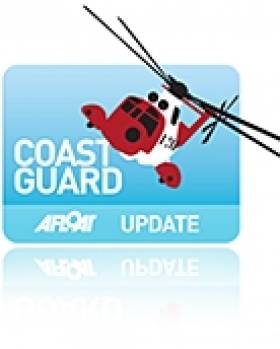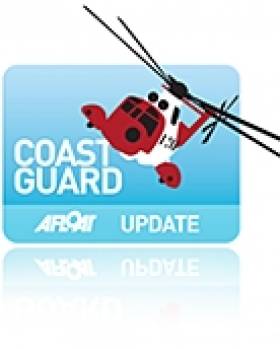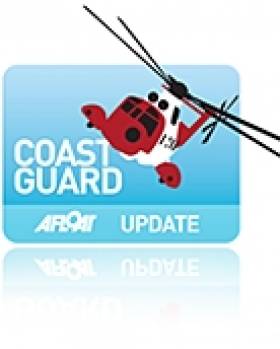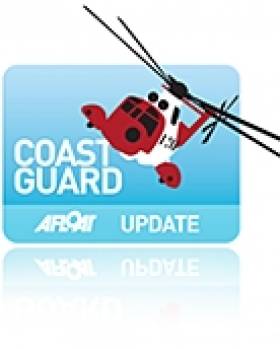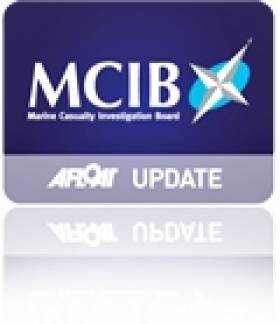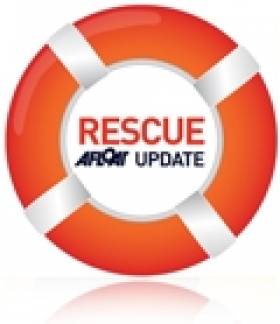Displaying items by tag: Coastguard
Largest Ever NI Maritime Exercise Takes Place on Belfast Lough
#coastguard – Exercise Diamond, the largest maritime exercise ever held in Northern Ireland, has taken place today within Belfast Lough. The exercise has tested the response by those involved in maritime search, rescue and recovery to a major maritime incident.
The exercise began with the following scenario:
There had been a 'collision', caused by an electrical fault, between the passenger vessel, 'MV Lough Explorer' which had 120 people on board and a commercial roll on roll off ferry, which had 50 passengers and 23 crew on board. The 'collision' had caused damage to the bow of the Lough Explorer and the hull of the ferry. The Lough Explorer was sinking rapidly and the master of the ship had broadcast a mayday message and given the order to abandon the vessel.
The master of the ferry reported that he could see liferafts from the Lough Explorer and people in the water. His own vessel had begun to list and three trailers on the deck had rolled over, trapping two people. Another trailer had caught fire. The master had requested help with fire fighting, to free the trapped people and to evacuate 50 people from the vessel. A major incident had been declared.
As part of the live exercise, Belfast Coastguard coordinated an air and sea search and rescue operation involving the following:
Bangor RNLI inshore lifeboat
Donaghadee RNLI all weather lifeboat
Larne RNLI all weather lifeboat
Portpatrick RNLI all weather lifeboat
Belfast Harbour Pilot Boat
Rescue helicopter ICN (Irish Coastguard Sikorsky S92N – Dublin)
Rescue helicopter 177 (Royal Navy Sea King – Prestwick)
The lifeboats searched for the 100 people (simulated by numbered oranges and dummies) who were in the water following the sinking of the Lough Explorer. Twenty people (played by RNLI crew and MOD personnel) were in liferafts and were recovered from the water by the lifeboats. By the end of the exercise 115 'people' (91 oranges, four dummies and all of the personnel) had been landed ashore at Bangor. Coastguard rescue officers, Police Service of Northern Ireland (PSNI) and ambulance personnel then brought them ashore before they were transported to a casualty reception centre, which was set up at Bangor Leisure Centre by North Down Borough Council, Southeastern Health Trust and PSNI.
The rescue helicopters evacuated 30 people from the ship and airlifted them to a landing site at Newtownards airfield. They were met there by the Coastguard Rescue Officers, who took them to the Casualty Reception Centre which had been set up at Londonderry Park by Ards Borough Council, Southeastern Health Trust and PSNI. The helicopters also airlifted specialist rescue teams from the Northern Ireland Fire and Rescue Service and Northern Ireland Ambulance Service to the ferry, to assist with the emergency onboard.
Sue Todd, The Maritime and Coastguard Agency's Coastal Safety Manager for Scotland and Northern Ireland says:
"Today we have shown that Northern Ireland has all of the resources and planning in place to respond, should a major maritime incident arise. Of course, there will be lessons learned and all of the agencies involved will discuss how we can improve. 365 people have taken part in Exercise Diamond today and I would like to thank them all for their willingness and enthusiasm in playing their roles. I would also like to thank Stena Line for providing the ferry and Survitec for providing vital specialist equipment"
Diane Poole, Head of PR and Communications at Stena Line said: "Stena Line works hard on a daily basis to maintain its excellent safety record. Comprehensive exercises such as Exercise Diamond provide invaluable opportunities for us to put our major incident procedures and planning into operation to ensure that they are more than capable of coping with a major incident. In addition, the exercise will also give us a great opportunity to deploy our procedures in consort with a range of emergency and regulatory organisations. This will help all parties in the future in the unlikely event of an emergency of this nature occurring."
Jennifer Williams of Survitec Group said: "The Survitec Group is proud to be part of such an important maritime exercise. We hope that moving forward this will strengthen the emergency search, rescue and recovery procedures we already have in place in Northern Ireland."
Mayo Mountain Rescue Breaks Record for Call-Outs on Croagh Patrick
#COASTGUARD - Mayo's mountain rescue unit has reported its busiest ever period with an "unprecedented" 14 call-outs in just six weeks, according to The Irish Times.
Irish Coast Guard personnel assisted Mayo Mountain Rescue on four of the total, helping to winch people who had fallen while descending Croagh Patrick on the south side of Clew Bay.
The injury toll on the mountain - accounting for 10 of the 14 recovery efforts - has prompted Mayo County Council to seek planning permission for a helicopter landing pad higher up the 2,500-foot peak.
The news comes just after Enniskillen RNLI was names the busiest lifeboat station in the island of Ireland, with 23 launches between its two inshore lifeboats and two rescue water craft over the summer months.
Rescue Crews in Familiarisation Exercise with New Sikorsky S-92
#sikorsky – Crew from Lough Derg RNLI Lifeboat Station were one of the rescue services invited on a familiarisation exercise of the new Sikorsky S-92, with four crew from the Irish Coast Guard Search & Rescue Helicopter team, based at Shannon.
Crews from the Lough Derg RNLI Lifeboat Station, Limerick Marine Rescue and The Killaloe/Ballina Irish Coast Guard Unit were invited to a familiarisation exercise of the new, Shannon based, Irish Coast Guard Search and Rescue Sikorsky S-92 helicopter at Ballina, Co. Clare.
The helicopter landed on the GAA pitch in Ballina, Co. Clare at 16.40hrs. After greeting and a safety brief, we worked in teams of five and six. The helicopter crew each took a group for discussion and a tour. Liam Flynn, chief pilot with the IRCG search and rescue service, talked to the RNLI group about the helicopter and took our questions. Later, on the exercise, we got to see his phenomenal flying skills at close quarters.
Paramedic and Winchman, Gary Robinson, went through the differences that rescue crews should expect with the new helicopter, and later coordinated the basket transfer of a stretcher 'casualty' onto and off the helicopter whilst the engines were running. This exercise was to familiarise crews with the more powerful downdrafts from the Sikorsky S-92. He also briefed us prior to and then directed the winches.
This was an invaluable exercise, as we all work regularly with the helicopter crews on rescues. All of the organisations involved gave huge thanks to Joe Doolan, Chief Officer at the Killaloe/Ballina Irish Coast Guard Search and Rescue, for the hospitality laid on everyone following the exercise
Major Maritime Exercise 'Diamond' for Belfast Lough
#coastguard – A major maritime exercise, 'Exercise Diamond', which involves HM Coastguard, vessels, RNLI lifeboats, helicopters, search and rescue coordinators, Belfast Harbour, emergency services and local authorities will be held on Sunday 23 September from 9.30 am. Exercise Diamond, a live large-scale incident exercise, will be held within Belfast Lough, Northern Ireland and involve 365 people.
A briefing will take place in Bangor RNLI Lifeboat Station by the MCA media team at 8.40 am.
A vessel will be available for media representatives, for filming and photographing the exercise as it unfolds. The boat will depart from Bangor Marina at 09.00 am and is expected to return at roughly 11.00 am. There will be limited places on board so please contact the MCA press office as soon as possible to book a place.
The RNLI will be supplying footage, taken from lifeboat cameras during the exercise. Further detail about where this can be obtained will be available nearer the date.
The exercise director and other exercise players will be available on the day for interview. Please contact the MCA press office in advance to make bids for interviews.
Steve Carson, who is the Exercise Controller says:
"Exercise Diamond will test the major incident plans for all of the organisations that would be involved should a major maritime incident happen in Northern Ireland. We would particularly like to thank Stena Line and RFD Survivitec who will be providing vital resources for the exercise."
Down Coastguard Officers Commended for Rescues
#COASTGUARD - The Newry Times reports on the award of the Chief Coastguard's Commendation to two Co Down coastguard officers for separate rescues last year.
Keith Campbell and John Kirkpatrick of the South Down Coastguard Team were recognised by the Maritime and Coastguard Agency at an awards ceremony in Newcastle Coastguard Station last Wednesday in what was also a first for Northern Ireland.
Alliance Party Councillor Patrick Clarke congratulated the officers for showing "exemplary bravery in carrying out their duties last year saving the lives of adults and children at separate incidents at Dundrum Inner Bay."
Chief Coastguard Peter Diamond from headquarters in Southampton made the presentation at the event attended by senior coastguard officers and officials from other emergency services.
Donegal Coastguard's Cliff Rescue Service May Be Scrapped
#COASTGUARD - The Donegal Democrat reports that the northern county may soon lose the cliff rescue service supplied by the Bunbeg coastguard unit.
Irish Coast Guard spokesman Gerard O'Flynn confirmed that the recent Fisher Report commissined by Minister for Transport Leo Varadkar "recommends that the Bunbeg unit should just continue as a coastguard boat and search team and no longer offer the cliff rescue element of their operation."
He added: "There has been no decision taken on this. It is only contained in the report, it is at discussion level."
As previously reported on Afloat.ie, the same 'value for money' report has recommended the closure of both coastguard radio stations at Malin Head and Valentia Island.
The Bunbeg unit, which comprises 23 volunteers in total, covers much of the county's northwestern coastline from Rosbeg to Horn Head which has become a popular spit for climbers both on the mainland and offshore on the likes of Tory Island and Arranmore.
#COASTGUARD - Campaigners opposed to the closure of the Clyde coastguard station in western Scotland will next Friday hold a red flare protest against the UK government's plans.
STV News reports that a flotilla of boats will gather at the Greenock Navy Buildings on the evening of 31 August to release red flares in "a show of thanks for the coastguard for their hard work and dedication", acccording to Save Clyde Coastguard campaign founder John Houston.
He added: "We realise that the centre is going to close. That is a given. It would take a miracle now to have that rescinded by the government."
As previously reported on Afloat.ie, staff at the Clyde station had their hopes of a reprieve dashed after a U-turn on assurances from British Prime Minister David Cameron.
The scrapping of the control centre at Greenock will see the loss of 31 jobs, with future River Clyde rescues being handled from stations around Scotland until 2015, when responsibilty will transfer across the North Channel to the Bangor control centre in Northern Ireland.
Campaigners and staff alike have shown concerns over the loss of local knowledge that could be vital to saving lives in difficult search and rescue operations.
STV News has much more on the story HERE.
Irish Coast Guard's New Smartphone App Aims to Save Lives
#COASTGUARD - A new smartphone app from the Irish Coast Guard could save dozens of lives, as the Irish Independent reports.
The new technology allows the coastguard to track vessels at sea, and automatically prompts a search and rescue effort if they do to return to port as expected.
"The whole idea is to encourage mariners to inform us when they are going out to sea," said Malin Head district commander Derek Flannery. "When and where they plan to go, when they plan to return and how many are going."
It is hoped that the new app will encourage seagoers to me more conscious of altering emergency services to their movements, in the wake of very recent tragedies off Spanish Point in Co Clare and the Beara Peninsula in West Cork.
They system works by asking mariners to input details about their excursions - such as destination and expected return time - into the app before they set off. The app will also track the vessel's movements via GPS.
"We'll text the boater to remind them to check in but if we don't get a response we can send out a crew," added Flanagan.
According to TheJournal.ie, the iPhone-only app is currently being trialled by sailors, divers, fishermen, powerboaters and pleasurecraft users throughout Ireland, and there are plans to develop the app for a range of smartphones.
“Getting to casualties early is the key for our search and rescue units," said Dublin Bay North TD Seán Kenny. "This new app has the potential to get our resources on-scene as quickly as possible which will in turn save lives.”
Four Deaths At Sea Set To Be Investigated
#MCIB - The bodies of two fishermen missing off Co Clare have been recovered, as The Irish Times reports.
Local divers found the remains shortly before lunchtime yesterday near Spanish Point as coastguard teams searched for a missing fishing boat.
As previously reported on Afloat.ie, the Lady Eileen - with two crew on board - was due to return to Quilty on Monday evening.
Searchers discovered debris and diesel in the water near Spanish Point in the early stages of the search on Monday night.
Meanwhile, the body of a father-of-three from Clare Island in Co Mayo was recovered from the sea by local fishermen last night.
The man - whose name is being withheld till all relations have been informed - was reported missing by a relative after he failed to return from a fishing trip in his currach.
The Marine Casualty Investigation Board (MCIB) is expected to open investigations into both incidents, as well as the death of John O'Leary of Allihies in West Cork, who lost his life after the Enterprise dinghy he was sailing with his son capsized off the Beara Peninsula on Monday.
Teen Injured in Water at Kilkee Pier
#RESCUE - A teenage boy was airlifted to hospital yesterday after an incident at Kilkee Pier in Co Clare.
The 17-year-old, understood to be from Limerick, sustained a serious injury after diving from the pier into shallow water.
The Irish Coast Guard station at Valentia Island co-ordinated the recovery effort, with the local coastguard and paramedics sent to the pier after the alarm was raised at lunchtime yesterday.
As The Irish Times reports, the new Shannon rescue helicopter was also tasked to the scene amid concerned that the teen had injuries to his head, neck and back.
Rescuers waded into the water to recover the young man, who was treated at the scene for a serious head wound before being driven to the local golf club to the makeshift helicopter landing spot, from where he was airlifted to Galway University Hospital for treatment, according to RTÉ News.
Kilkee Marine Rescue Service chairman Manuel Di Lucia said that authorities "need to consider" the absence of a dedicated helicopter landing site in Kilkee closer to the pier.


























